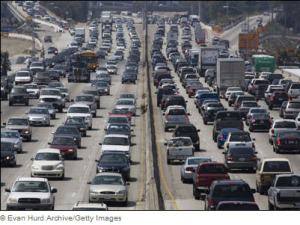 Whether or not congestion is "good" is one thing. But what is for sure is that one way or another congestion is policy, or at the very least a policy option. And in some cases quite possibly a wise one. Now this has been said many times by any people in many places, yet despite its incontrovertible wisdom the message continues to get lost on policy makers. So in cases like this, we have to take a page out of the book of good people who us sell soap and cars, and keep repeating our message. Today, let's hand over the podium to Kent Strumpell from Los Angeles and see what he had to say on our subject in LA Streetsblog back in early 2008. To this reader it has lost none of relevance over almost half a decade. Read on.
Whether or not congestion is "good" is one thing. But what is for sure is that one way or another congestion is policy, or at the very least a policy option. And in some cases quite possibly a wise one. Now this has been said many times by any people in many places, yet despite its incontrovertible wisdom the message continues to get lost on policy makers. So in cases like this, we have to take a page out of the book of good people who us sell soap and cars, and keep repeating our message. Today, let's hand over the podium to Kent Strumpell from Los Angeles and see what he had to say on our subject in LA Streetsblog back in early 2008. To this reader it has lost none of relevance over almost half a decade. Read on.
Why Congestion is Good
- by Kent Strumpell.Los Angeles. Friday, February 1, 2008
Source: http://la.streetsblog.org/2008/02/01/why-congestion-is-good/ by Damien Newton.
Bemoaning the evils of congestion has become perhaps the most common complaint heard about urban living today. Everyone groans about it but few do anything meaningful to lessen their contribution. Somehow government is supposed to solve it, but we all know how well that has worked. Stuck with it and stuck in our ways, here then, is a partial list of the benefits of being stuck in traffic.
1. Congested traffic is one of the few restraints on excessive automobile use. When a limited commodity like road capacity is free and demand is high, the result is invariably overuse. Heavy traffic causes most drivers to think twice before using their cars at peak hours and encourages many to carpool, use alternative travel modes or move closer to their most common destinations.
2. The daily experience of congestion can increase public support for investments in more fuel-efficient, environmentally sustainable travel modes such as public transportation, cycling and walking, which have multiple societal benefits and need more support.
3. Congestion can improve the experience of activities adjacent to roads. Roads with slow moving traffic are more conducive to walking, shopping, outdoor dining, conversing, crossing the street, children’s play on sidewalks, etc. On streets with fast, noisy traffic, all of these activities are less viable and less enjoyable.
4. Slow traffic is safer. It is an established fact that motor vehicle collision severity increases dramatically as speeds go up. Slower moving traffic also increases safety for pedestrians and cyclists.
5. Congestion can increase the value of retail property. When cars are able to speed by at or above the speed limit, motorists are less able to notice roadside businesses. When traffic slows down or stalls, drivers have more opportunity to take note of and stop to visit businesses.
6. Slower traffic can reduce energy consumption. The speed at which motor vehicles achieve their greatest fuel efficiency and lowest emission levels is around 30mph (admittedly, stop and go traffic makes matters worse). Above 30mph, aerodynamic drag increases fuel consumption in most cars.
7. Slower traffic can improve road efficiency. 25-35mph is the speed at which roadways achieve their greatest carrying capacity. Above that, it diminishes as the space between cars increases.
The point of this list isn’t to welcome or encourage congestion, but to point out the often-overlooked negative side effects of trying to eliminate it. Congestion may well be a condition preferable to what would be needed to continually alleviate it. If it’s any consolation, every prosperous city in the world has congestion (though many also provide pervasive alternatives to driving).
The solution to clogged roads will not be found in some optimized combination of highway improvements, advanced technology and behavioral tweaking. Instead, the key to becoming less burdened by traffic is to build and retrofit our communities so we can meet an increasing number of our daily needs without driving. Of course, not everyone is able to live close to their work, but many more could if land use planning encouraged and facilitated the creation of compact, walkable, mixed-use communities rather than automobile-oriented places with segregated uses. And travel to work is but one type of trip; many other excursions are to destinations that are easier to locate close to homes.
Roads in urbanized areas will probably always experience congestion. Our options for relieving it are increasingly limited and expensive. But if we design our communities to provide for more of our needs without driving, more of us could choose to opt out of congestion.
# # #
Kent Strumpell is a member of the board of directors of the Los Angeles County Bicycle Coalition and an a transportation and community planning advocate.
# # #
 Print this article
Print this article



Vehicular congestion on highways is a pathology imposed by transport policy. Congestion in terms of aggregations of people in central places is an evolved attribute of geogrpahy and society. The two should not confused. There is nothing good about a policy that leads to harmful spillovers and disruption of places from traffic.
ReplyDelete[...] here : Congestion as policy. (I have seen worse.) (Eric Britton, WorldStreets, Nov. 28, [...]
ReplyDelete